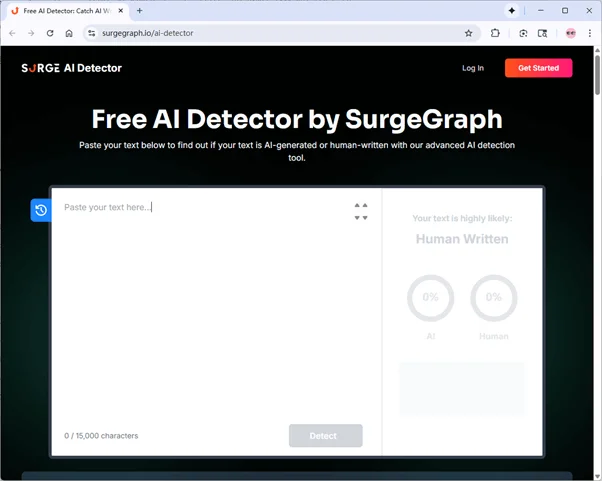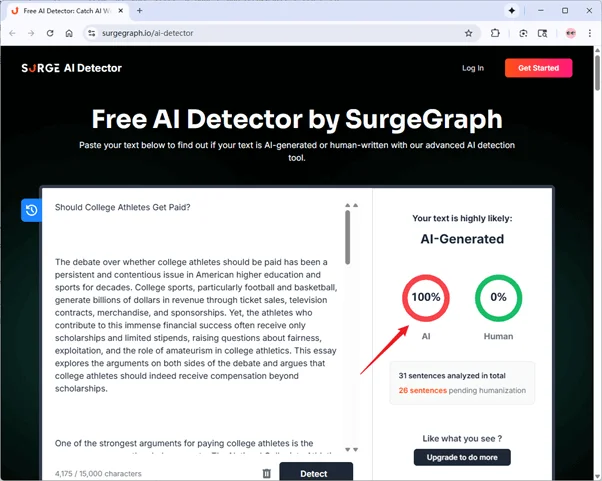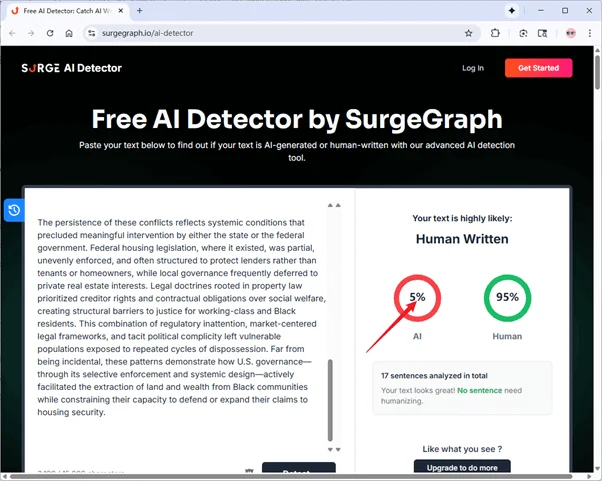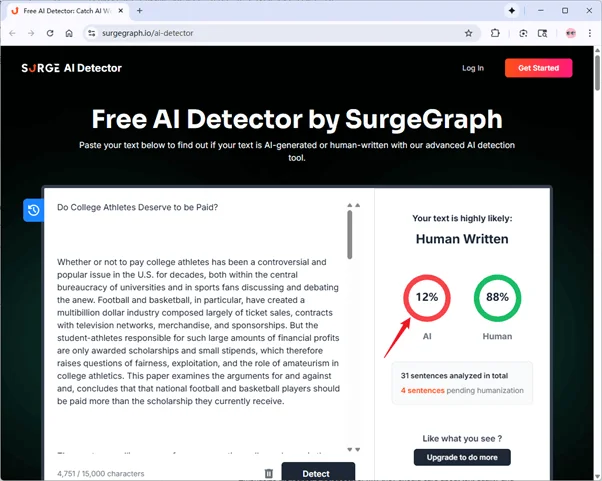SurgeGraph AI Detector Review: What 3 Real Tests Reveal

When it comes to checking if text is AI-generated, tools like SurgeGraph AI Detector are becoming more common.
You might be curious about how accurate it really is, especially with mixed or humanized writing.
In this review, we put it to the test with different types of text and break down what the results mean.
By the end, you’ll have a clearer idea of how to interpret its scores and apply that insight to your own work.

What Is SurgeGraph
SurgeGraph is an AI-powered content and SEO platform built to help writers, marketers, and bloggers create long-form articles that perform well on Google.
It started as a writing and optimization suite focused on driving web traffic, but over time, the platform expanded into AI analysis tools, including an advanced AI detector.
What Is SurgeGraph AI Detector
The SurgeGraph AI Detector is designed to tell whether a piece of writing is human-written, AI-generated, or a mix of both.
It provides sentence-level tagging and detailed scoring, helping users pinpoint where AI influence appears in their text.
How it works:
Uses deep learning, natural language processing (NLP), and large language models (LLMs) trained on thousands of samples of human and AI text.
Detects subtle linguistic traits such as rhythm, grammar flow, tone, and phrasing patterns.
Employs format-proof analysis, meaning it remains accurate even if users tweak layouts, add bullet points, or change formatting.
Core functions:
AI text detection: Identifies content fully or partially written by models like GPT-4, Claude, Gemini, and LLaMA.
Mixed-content detection: Flags sentences where AI writing blends with human text, rather than marking entire documents as one or the other.
Sentence tagging: Labels each line as “Human” or “AI” for easy editing and rewriting.
Verification layer: Tests whether your text passes detection across major AI checkers for added reliability.
Supported formats:
Users can paste text directly into the interface or upload documents in formats such as DOCX, PDF, or TXT. There’s also API access for workflow integration, and while English is the main supported language, the detector can handle limited multilingual content with varying accuracy.
Extra Tools of SurgeGraph
Beyond its AI detector, SurgeGraph offers several other tools for writers and teams working with digital content:
AI Humanizer – Rewrites detected AI sentences to sound more natural and human-like.
Long-form AI Writer – Generates SEO-focused blog posts, guides, and listicles based on chosen keywords.
Outline Builder & Optimizer – Creates structured outlines and improves existing drafts for better readability and search ranking.
Batch and bulk checking – Allows scanning or humanizing multiple documents at once, useful for editors or educators reviewing many submissions.
How Accurate Is SurgeGraph AI Detector
SurgeGraph advertises a striking 99.7% detection accuracy and claims its system can even catch paraphrased or humanized AI text.
That sounded impressive on paper, but I wanted to know how well it actually performs in practice.
To find out, I ran three tests—one using fully AI-generated text, another combining human and AI writing, and a final one using AI text rewritten by a humanizing tool.
Test 1: Pure AI Text
Setup:
For this first test, I generated a full paragraph using ChatGPT-5 with no human edits. The goal was to see if SurgeGraph could correctly recognize it as fully AI-written.
Results:
SurgeGraph labeled the text as 100% AI.

Observations:
This outcome matches expectations and supports the tool’s claim of strong recognition accuracy for fully machine-written content. The sentence-by-sentence tagging also made sense—every line was flagged as AI, with a consistent “mechanical” pattern. So far, the detector performs as advertised for purely artificial text.
Test 2: Mixed AI + Human Writing
Setup:
For this test, I took an older academic paragraph written before ChatGPT even existed (clearly human-authored) and asked ChatGPT-5 to continue it. The resulting text was 454 words total, with 187 words (about 41%) from the human portion and the rest generated by AI.
Results:
SurgeGraph marked the text as 5% AI.

Observations:
This result was unexpectedly low. While the human section should naturally pass as authentic, the AI continuation was barely flagged. That suggests SurgeGraph may struggle when AI writing blends seamlessly with human tone and structure. In real-world terms, mixed or co-edited drafts might easily slip through undetected.
Test 3: Humanized AI Text by QuillBot
Setup:
Here, I took the 100% AI text from Test 1 and ran it through QuillBot’s Advanced Humanizer mode, which is designed to disguise AI phrasing.
Results:
SurgeGraph rated the humanized version as 28% AI.

Observations:
The score shows that SurgeGraph does detect some traces of artificial language even after heavy paraphrasing—but it clearly misses more than half of the content’s AI origin. In practice, that means the detector has limits when text is rewritten or passed through a humanizer.
Pros and Cons of SurgeGraph
Pros
Easy to use, even for beginners
The interface is responsive and straightforward. You can paste, upload, or scan documents without extra setup, and results appear almost instantly.
Sentence-level analysis
Unlike many detectors that only give one overall “AI score,” SurgeGraph marks each sentence as AI or Human. This makes it easier to pinpoint and edit problematic sections instead of rewriting the whole piece.
Supports long-form and formatted text
It can process up to 25,000 characters per scan and still read through lists, quotes, or headings accurately.
Cons
Occasional false positives and misses
Some purely human paragraphs may still be flagged as AI, primarily when the writing is overly structured or formal. On the other hand, heavily edited or paraphrased AI text sometimes slips through undetected.
Mixed-content detection inconsistency
Tests show that the detector struggles when human and AI writing are combined in one document. It often labels such hybrid text as mostly human, underestimating AI contribution.
Performance variation in non-English text
The detector seems optimized for English; other languages may yield inconsistent accuracy.
SurgeGraph Pricing
Free Plan
The free plan allows up to 80,000 words of AI detection per month and 5,000 words for humanization. However, it only supports plain text input (no file uploads), doesn’t include batch or team features, and runs at standard processing speed.
Paid Plans
If you need more frequent or professional-level use, SurgeGraph offers three paid tiers — Essential ($10/month), Premium ($19/month), and a Lifetime plan ($119 one-time). All of them increase the AI detection and rewriting limits to at least 200,000–450,000 words per month, which is useful for regular academic or editorial work.
Paid users also unlock:
File uploads in PDF, DOCX, TXT, or MD formats.
Batch checking for up to 20–45 files at once.
Faster processing speeds (up to 5× faster than the free version).
API access for workflow integration.
Advanced analytics and exportable professional reports.
Priority or 24-hour support, depending on the tier.

Can You Bypass SurgeGraph AI Detector
The short answer is no, not completely. The goal isn’t to deceive the system but to make AI-assisted writing sound more natural and human-like. SurgeGraph’s detector is trained on extensive datasets, allowing it to catch common AI phrasing patterns and overly uniform sentence structures.
Simple rewriting or word swaps—like those done with QuillBot’s advanced mode in Test 3—aren’t enough. The text was still flagged as 28% AI, staying well above the “safe” range of below 20%.
That’s where EssayDone Humanizer comes in. It’s built to humanize AI text by changing not just the words but the linguistic and structural patterns underneath. Instead of relying on synonym replacement, it reshapes sentence rhythm, phrasing, and flow to reflect genuine human reasoning.

By enhancing syntactic variety and natural transitions, EssayDone Humanizer makes writing statistically less predictable to detectors. When tested on the 100% AI text from Test 1, it reduced SurgeGraph’s detection score to just 12% AI, showing clear gains in both authenticity and readability.

Alternatives to SurgeGraph AI Detector
Tool | Multilingual | Free Plan | Paid Plan | File Formats | Login Required | Sentence-Level Analysis | Extra Features |
Originality.ai | Yes | Limited trial only | From $12.95/mo (200k words, 2k credits) | PDF, DOCX, DOC, site scans | Yes | Yes | Plagiarism check, fact check, readability, grammar, team tools, Chrome extension |
GPTZero | Yes | 5,000 characters/test | From $14.99/mo (100k chars) | PDF, DOC, DOCX, TXT (50MB max) | Yes | Yes | Writing feedback, plagiarism check, citation tools |
Copyleaks | Yes (30+ langs) | 15,000 characters/test | From $16.99/mo (100k chars) | Copy-paste only | No | No | AI + plagiarism in one report, shared data hub, Google Docs add-on, Chrome extension |
ZeroGPT | Yes | Yes | From $9.99/mo | Text only | No | No | Plagiarism check, AI summarizer, AI paraphraser |
QuillBot | Yes | 1,200 words/test | From $8.33/mo, Unlimited Scan with premium | Multiple (DOCX, TXT, etc.) | No | Yes | Paraphraser, summarizer, grammar check, plagiarism check, text humanizer |

FAQ
Is SurgeGraph 100% accurate?
No. SurgeGraph performs well on many synthetic AI texts, but it’s not perfect. It can miss AI that’s been heavily blended with human writing or aggressively humanized, and it can sometimes flag natural human phrasing as “AI.” Treat its score as a helpful signal, not an absolute verdict.
How to bypass SurgeGraph AI detector?
Simple word swaps or paraphrasing tools often fail to fool SurgeGraph. In our tests, even QuillBot’s advanced mode couldn’t lower the AI score. For reliable results, you’d need a professional humanizer that rewrites structure and tone naturally.
Will my professor use an AI detector?
Possibly. Some instructors or institutions use AI-detection tools or services (and many use plagiarism checkers like Turnitin). Others rely on style checks, oral defenses, drafts, or human review. Policies and tools vary widely by department and school — when in doubt, check your syllabus or ask your instructor.
Can I use AI detectors on my own work before submission?
Yes — and I recommend it. Running your drafts through a detector can highlight overly “AI-like” passages and point you toward sections that need more personal insight, clearer argumentation, or citation. Use the results to edit and improve, not to game the system.
Are AI detectors legal?
Yes, using AI detectors is legal. However, how schools use detector reports is governed by academic policy and local rules (due process, appeals, etc.). The legal issues usually involve privacy or institutional policy rather than the detectors themselves.
Is SurgeGraph AI Detector free?
Yes — SurgeGraph offers a free tier with limited monthly detection and humanization quotas (enough for light use or testing). Paid plans raise word limits, add file uploads and batch processing, faster speed, API access, and priority support. If you do a lot of checking (multiple assignments or long papers), a paid tier or institutional tool may be worth considering.
Conclustion
Overall, we ran tests on different types of writing to see how it performs and where it struggles.
You’ll notice it catches clear AI patterns fairly well, but mixed or humanized text can be trickier.
Hopefully, going through these examples gives you a better sense of what to expect when using AI detectors on your own work. Take these insights as guidance for improving your writing, rather than relying solely on the scores.
